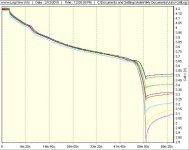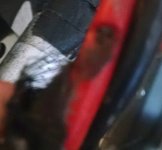Bigbikebob
10 W
I have a MagicPie 3 motor upgraded 10awg phase wires overclocked to 2KW
connected to External LYEN Edition Controller 12 FET 3077 Mark II Extreme Modder HSL Sensorless controller (with 12awg power wires) and powered by a 48V 20Ah LiFePO4 battery (60A BMS) that can supply up to 40A of contentious current
http://www.conhismotor.com/ProductShow.asp?id=47
I run my controller at 40A which is the upper limit of my battery.
I used my bike in the configuration for about 3 months without any problem.
Yesterday while standing at the foot of a hill ( I climb everyday) I twisted my throttle slowly and got a power cutoff. when I let go of my throttle and tried again, this time more slowly I was able to gain speed and once I was going fast no cutoff happened,
I tried to duplicate the cutoff and was able to do so (many times) while I was trying to start going up the hill.
I checked my setup (the voltage output of the battery was a solid 52.2V while the battery was disconnected from the controller) and could see that my phase bullet connectors looked new, My Anderson connector at the end of the controller power wires looked good. My Anderson connector form at end of my battery had yellow-black color on it.
I reprogrammed my controller to run at 35A and recharged my battery and while riding today had no cutoff.
This problem started after about 3 months and didn't occurred from the start , the question is why and why only under load trying to go uphill?
Edit: I have attached a picture of the controller settings.
connected to External LYEN Edition Controller 12 FET 3077 Mark II Extreme Modder HSL Sensorless controller (with 12awg power wires) and powered by a 48V 20Ah LiFePO4 battery (60A BMS) that can supply up to 40A of contentious current
http://www.conhismotor.com/ProductShow.asp?id=47
I run my controller at 40A which is the upper limit of my battery.
I used my bike in the configuration for about 3 months without any problem.
Yesterday while standing at the foot of a hill ( I climb everyday) I twisted my throttle slowly and got a power cutoff. when I let go of my throttle and tried again, this time more slowly I was able to gain speed and once I was going fast no cutoff happened,
I tried to duplicate the cutoff and was able to do so (many times) while I was trying to start going up the hill.
I checked my setup (the voltage output of the battery was a solid 52.2V while the battery was disconnected from the controller) and could see that my phase bullet connectors looked new, My Anderson connector at the end of the controller power wires looked good. My Anderson connector form at end of my battery had yellow-black color on it.
I reprogrammed my controller to run at 35A and recharged my battery and while riding today had no cutoff.
This problem started after about 3 months and didn't occurred from the start , the question is why and why only under load trying to go uphill?
Edit: I have attached a picture of the controller settings.





